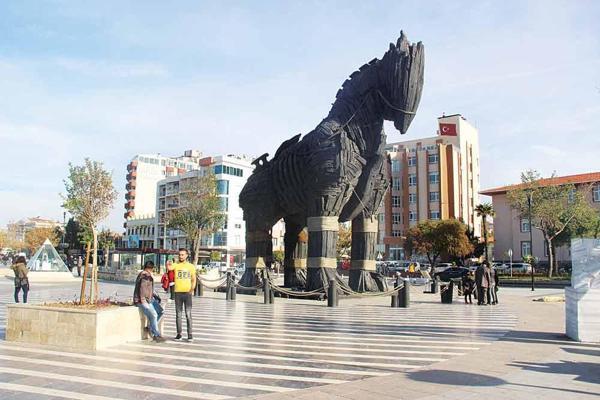The Trojan horse: A horse or a boat?
ÇANAKKALE - DHA


Italian naval archaeologist Francesco Tiboni has claimed that the Trojan horse was actually a boat, not a horse.
Tiboni’s argument, covered widely in the Italian media last week, concerns the symbol of the 5,000-year-old ancient city of Troy, the site of which is located in the present-day village of Tevfikiye, in the northwestern province of Çanakkale.
The head of the Troy excavations, Professor Rüstem Aslan, says Tiboni’s claims will not change the legend of the Trojan horse, which has fascinated people for thousands of years.
Aslan, who is also a staff member of Çanakkale Onsekiz Mart University (ÇOMU), says Tiboni’s suggestion is just the latest in a history of speculative theories surrounding the Trojan War, going back to ancient times.
Archaeological excavations in Troy began over 150 years ago, and Aslan has been working there since he was a student.
Although Homer’s epic verse poems the “Iliad” and the “Odyssey” both deal with the Trojan War, only the latter mentions the Trojan horse.
“The Trojan horse is briefly mentioned in the seventh book of the Odyssey epic. The passage says that the hero Odysseus and a group of Greek soldiers hid in the Trojan horse in order to launch a surprise attack on the Trojans,” Aslan said.
Aslan has also stated that the veracity of the horse described by Homer is an age-old question, and one that has spawned many “answers.” While many researchers affirm Homer’s version of events, American archaeologist Carl Blegen, who carried out excavations in Troy between 1932 and 1938, claimed that the city collapsed during an earthquake after which Achaean soldiers were able to conquer Troy. The horse, he argued, is a symbol of the earthquake god Poseidon, and has therefore symbolic but not literal value.
“But the theories do not stop there. Many horse bones have been discovered at the site of the ancient city, with recent excavations also unearthing a defense ditch in the lower part of city that was built used to prevent chariots coming close to the castle. According to Aslan, these recent findings indicate that chariots were the most important war-tools in the era, known as the Homeric era. And to have chariots, you also need horses.
“The Greeks needed a sufficient number of horses and chariots to win the war. Homer, however, also uses the symbol of the horse in a metaphorical way. He is saying that military prowess is not enough and that ideas are important too,” he said.
The Italian archaeologist’s claim enjoys little favor among researchers and will soon be forgotten, said Aslan. “The Homeric epics are important in terms of cultural history and many researchers suggest such theories in order to make their name heard,” he added.
“People have been interpreting the Trojan horse for thousands of years. The interest will continue,” he said.
Trojan horse used in Brad Pitt’s film
Brad Pitt’s 2004 film “Troy” is based on legend of the Trojan horse and the model horse used in the film is on public display in Turkey. “The horse in that film was made from the keels of old boats and is currently on display in a public square in Çanakkale,” Aslan said. He also noted that archaeological findings have not unearthed any signs of the “real” Trojan horse, stressing that the Trojan horse is a “mythological element associated with a specific historical event.”
